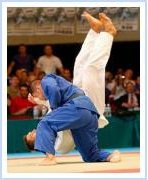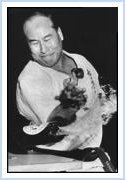Frequently Asked QuestionsIf you would like to reuse any of the following content please credit the DCU Karate Club website as the original source. |  |
Introduction
|
The following are some quick answers to questions frequently asked by people new to karate. If your question isn’t answered here, it may be dealt with elsewhere on this site. If all else fails, try asking one of the club instructors! (Note there is also a very good FAQ section on the JKA website here.) |
Q1: How do I start? Will I need any special equipment?
|
A: Just turn up at any of the club’s training sessions. You don’t need any special clothes or equipment to start with. Just make sure to wear loose fitting clothes – a t-shirt and track bottoms will do fine. Eventually though, you will be expected to wear a proper karate suit. If it is your first time training with us, make yourself known to the instructor or one of the committee members and they will sign you up and fill you in. |
Q2: Where can I buy a suit?
|
A: In Dublin, cheap karate suits (or “karate-gi” as they’re known) from about €30 can be bought from Mullen’s Sports, Mary St., Dublin 1. For a more extensive range of suits visit www.kamikazeweb.com |
Q3: What do the different colour belts mean?
|
A: The different colour belts that karate practitioners (or “karate-ka”) wear, are an indication of grade. Each grade up to black belt is called a “kyu”. Each black belt grade is called a “dan”. The sequence and colour of belts is: |
| Colour | Grade | Minimum Training Time |
| White | 10th kyu | |
| Orange | 9th kyu | Min. 2 - 3 months |
| Red | 8th kyu | Min. 3 months since last grade |
| Yellow | 7th kyu | Min. 3 months since last grade |
| Green | 6th kyu | Min. 3 months since last grade |
| Purple | 5th kyu | Min. 3 months since last grade |
| Purple | 4th kyu | Min. 3 months since last grade |
| Brown | 3rd kyu | Min. 3 months since last grade |
| Brown | 2nd kyu | Min. 3 months since last grade |
| Brown | 1st kyu | Min. 3 months since last grade |
| Black | 1st dan | Min. 6 months since last grade |
| Black | 2nd dan | Min. 2 years since last grade |
| Black | 3rd dan | Min. 3 years since last grade |
| … Black | … 10th dan | etc to 10th dan |
|
Note that the actual time between grades varies from individual to individual and depends on the frequency and intensity of their training. Also, different karate styles and organisations will sometimes use a slightly different sequence of colours. |
Q4: What’s the difference between karate and other martial arts?
 Action from the 2003 World Judo Championships. |
A: The main focus of karate is to deal with an attack through evasive body movements and/or blocking, and counter attack using kicks, punches and strikes. Joint locks, restraints and takedowns are also used, but to a lesser extent. This compares with arts such as judo and aikido which depend mainly on throws and restraints, or taekwondo which places more emphasis on kicking than karate. It’s not a case of any one art being better than any other – each one just takes a different approach. Because of this, different arts suit different people. |
Q5: What’s the difference between Shotokan and other styles of karate?
|
A: There are many different styles of karate, each with its own emphasis and characteristics. For example, styles such as Wado-ryu and Shito-ryu are characterised by light, fast movements while styles such as Goju-ryu and Kyokushinkai are typified by heavy, strong techniques. Shotokan lies somewhere in the middle with elements of both light and heavy styles. The main focus of Shotokan is learning, through correct technique, how to use your body to generate as much power as possible as efficiently as possible, and then using this power to apply defensive and offensive techniques (particularly those from the various kata) against an attacker. |
 Mas Oyama (1924-94), founder of Kyokushinkai. |
Q6: What are karate competitions like?
 T. Naka & Y. Ogura clash during the JKA National Championships of 1987. |
A: There are different types of karate competitions with different rules. The type that the DCU club enters are generally “semi-contact”. That means light contact is allowed, but if a competitor uses excessive contact or injures their opponent, they will be disqualified. Bouts are usually “shobu-ippon” (first to score 1 full point or 2 half points within a predetermined time wins) or “shobu-sanbon” (first to score 3 full points or 6 half points within a predetermined time wins). There are also kata competitions, where competitors are judged on their performance of kata, both individually and in a synchronised manner as part of a three person team. |

